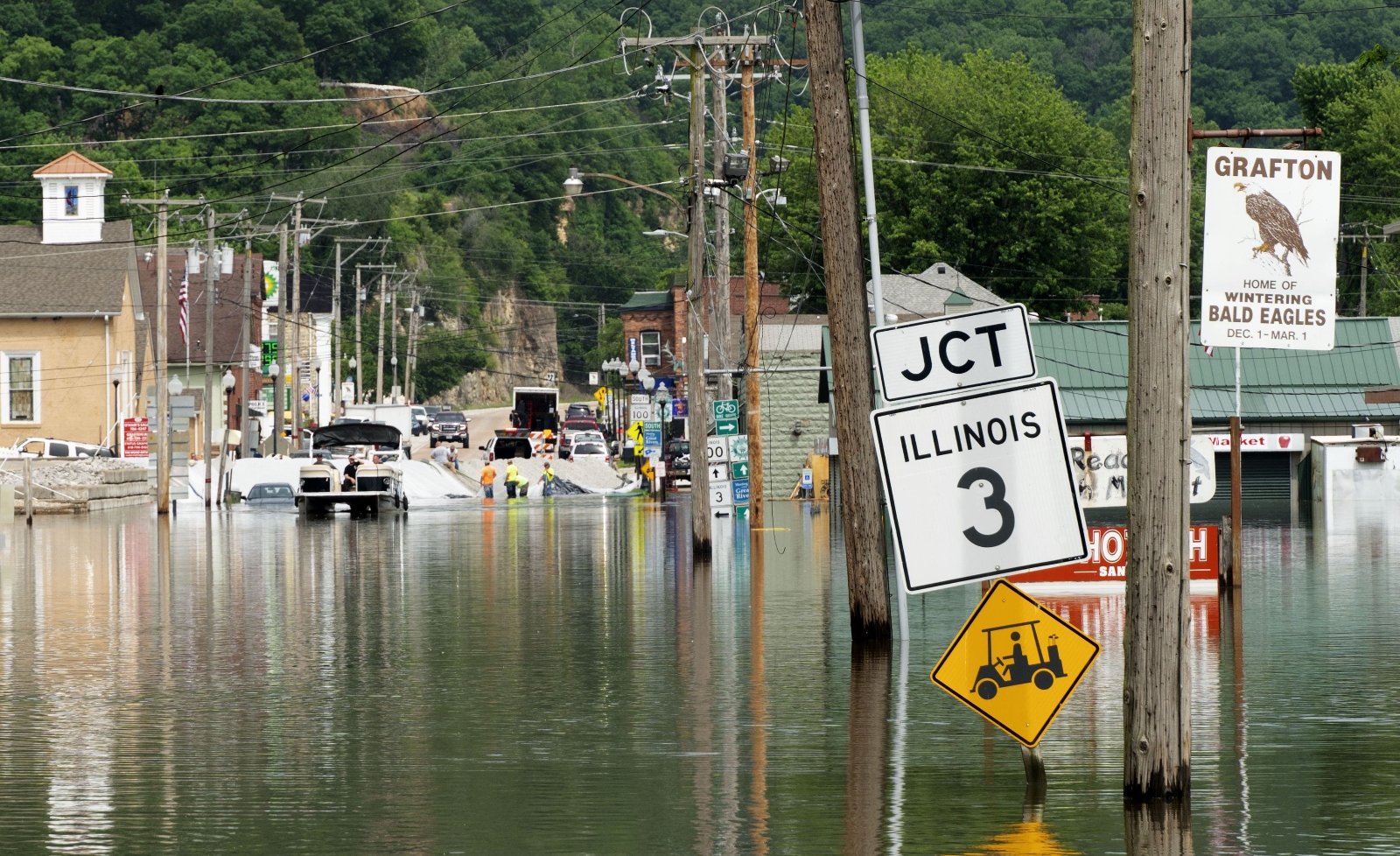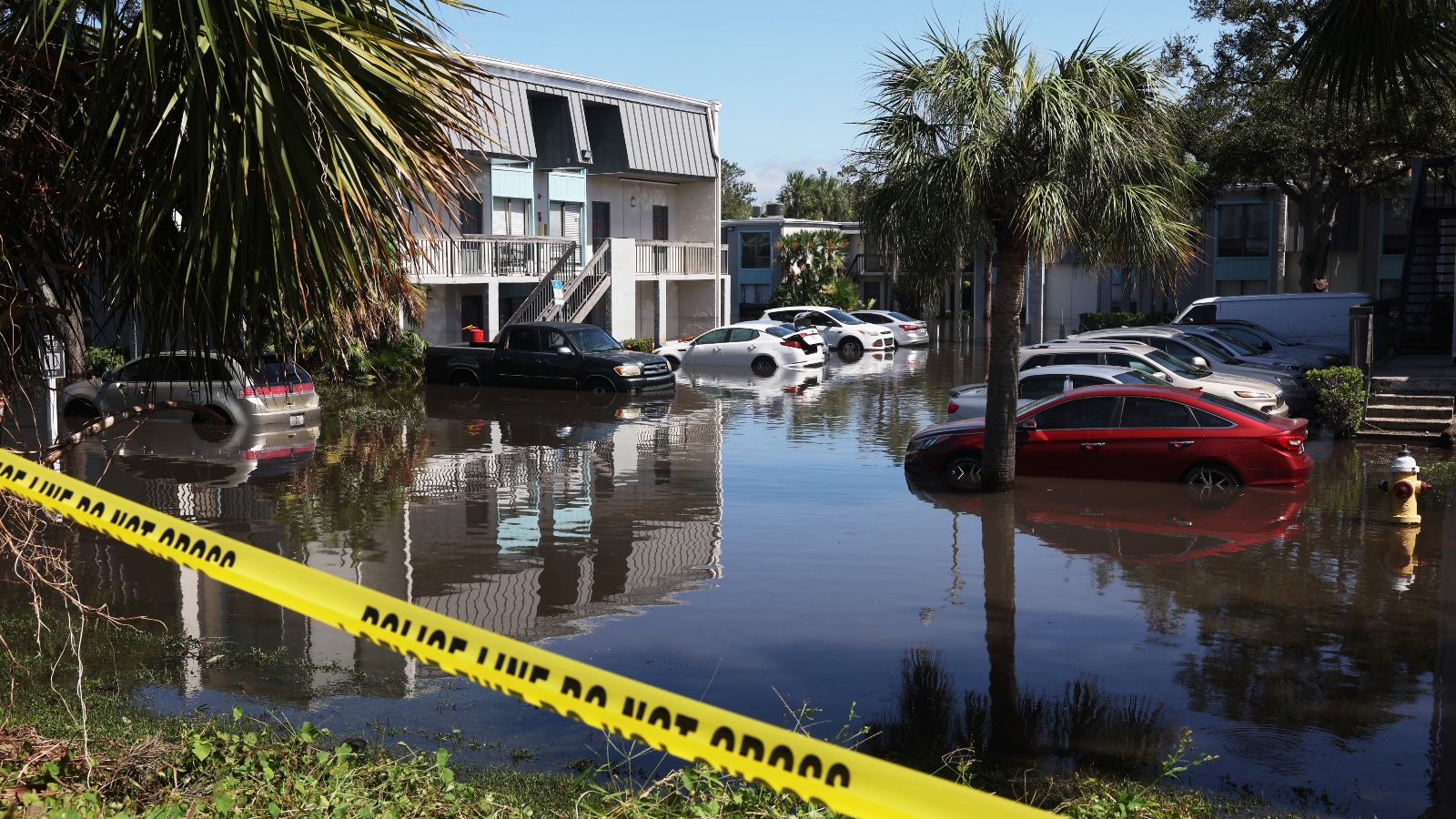This story was originally published by St. Louis Public Radio.
Early on Election Day, highways in the St. Louis area were inundated with water. Over several days, intense storms battered Missouri, bringing six to 10 inches of rain — record-breaking amounts for November.
The flash flooding killed at least five people, including two elderly poll workers whose vehicle was swept from a state highway.
Mayors along the Mississippi River have watched for years as intensifying rain storms and flooding wreak havoc on their communities.
Take Grafton, Illinois, which escaped Election Day flash flooding but suffered $160,000 to $170,000 in damages from a heavy rain event in July. The town’s main intersection was blocked with logs and debris, and the storm blew out a water line and left streets in need of repair.
But Grafton never received a federal disaster declaration and was not eligible for assistance from the Federal Emergency Management Agency (FEMA). Instead, it paid for road and water-line repairs through its Department of Public Works’ annual budget. As a result, the city could no longer purchase new trucks for snow plowing this year, as it had planned.
“What it means is that we’ll limp through another year, keep the vehicles running,” said Grafton Mayor Michael Morrow, who oversees the $1.2 million annual budget for the small riverfront city of about 600.
River communities have suffered repeated losses. But federal disaster funding can take weeks, months or even years to pay out. Traditional insurance programs are tied to property and require proof of loss for a payout, which can be burdensome and lengthy to assemble.
So this fall, the Mississippi River Cities and Towns Initiative (MRCTI) announced a new insurance pilot, with hopes of better helping river towns recover.
MRCTI, which represents 105 cities along the 10 mainstem states of the Mississippi River Basin, is working with Munich Re, a German multinational insurance company, to create the insurance product.
The resulting pilot will test a novel type of insurance pool — called parametric insurance — that is designed to rapidly fund emergency response after natural disasters such as flooding.
Pilot will test usefulness of new “parametric” insurance policies
The likely cause of intensifying rainfall and floods is human-caused climate change, according to the Fifth National Climate Assessment, a scientific report created every four years for the United States Congress and the President, to help explain the impacts, risks and vulnerabilities associated with a changing global climate.
In 2019, communities in the Basin saw months of flooding, spanning across the Mississippi, Missouri and Arkansas rivers. Reported losses totaled almost $25 billion across at least 17 states, according to the National Oceanic and Atmospheric Administration.
The central U.S. is emerging as a new flash flooding hotspot, according to research published in Nature’s Communications Earth & Environment journal. With its new role as a hotspot comes more disaster damage – and need for insurance that addresses that.
While conventional indemnity insurance requires insured owners to prove specific losses by amassing evidence and presenting pre-storm documentation, parametric insurance pays out quickly after agreed-upon “triggers” – such as wind speeds or river heights – reach a certain level.

Brent Jones / St. Louis Public Radio
For the MRCTI pilot, Munich Re has suggested using watershed data from the U.S. Geological Survey to determine the best gauges along the river to measure flood depth. Once the river flooding reaches a certain depth, the payout would be triggered.
Getting that trigger right is key, said Kathy Baughman McLeod, chief executive officer of Climate Resilience for All, a nonprofit focused on climate adaptation.
“You want to have sufficient understanding of how you set the triggers at a certain place and why,” she said. “There’s a lot of engagement necessary to get everybody on the same page about what the product is, how it works, what the trigger should be.”
The goal of Munich Re’s pilot program is to demonstrate in real-time how a parametric insurance payout policy would function in current insurance-market conditions and how swift payouts could better assist a city’s disaster response in the immediate days following a flood.
First, Munich Re will develop a mock-up of the insurance policy for one hazard – flooding – with the understanding that multiple hazards, like intense heat, or drought, could be added later, said Colin Wellenkamp, executive director of MRCTI, and, as of November 6, a newly elected state representative for Missouri District 105.
The mock-up would calculate a range of premium costs and theoretical payout options that would be available for cities of varying sizes along the river. But the pilot won’t cost the cities a cent – and it won’t pay them anything either, until the pilot moves into implementation. It’s unclear which entities will ultimately foot the bill of the pilot and eventual product because it’s so early in development.
When Munich Re moves into implementation, individual city governments would hold the policies and receive payouts. Wellenkamp hopes to convince larger corporations that rely on a healthy and functioning Mississippi River hydrology to pick up the tab on the premiums, he said.
Quick payouts could take burdens off cities
“In the first 24 to 72 hours after a disaster event, very little money can help a whole heck of a lot,” Wellenkamp said. “We use that time for evacuations and to move people out of additional harm’s way in the aftermath.”
But soon after the initial emergency response, municipalities start to look for funds for longer-term cleanup and repair. Under the current paradigm, that money can be hard to tap.
In the spring of 2019, major flooding on the Mississippi inundated many communities, including Grafton, where the downtown partially closed and people were forced to evacuate.
The Trump administration didn’t declare a major disaster until September of that year, months after flood waters had receded. It took until 2022 for federal money to reach Grafton, Morrow said.
“The former administration went through that flood,” Morrow said. “I’m the mayor now and I was getting some of the money that they had put in years ago.”
That wait places stress on a city’s finances, especially smaller ones like Grafton, Morrow added.
Traditional insurance doesn’t always help either. Grafton has a flood policy but it only covers property owned by the city. Residents and businesses in the community would need to take out their own flood protection. The National Flood Insurance Program (NFIP), which underwrites many flood insurance policies, has various coverage restrictions. For example, NFIP doesn’t cover roads or wastewater infrastructure.
The policies also require proof of loss before issuing a check because they cover specific damage, like to a particular building or its contents. This “proof” can take days to document, and longer to process, which delays how fast a local government can begin repairs. Without proper pre-storm documentation, damage can sometimes be nearly impossible to prove.
Parametric insurance – which works with measurable triggers and isn’t tied to documentable losses – could ease the process.
Cities from the headwaters to the mouth of the Mississippi could buy into the policy, creating a pool that spreads out the risk that any individual community faces.
“Not every city is going to flood every year, but the flooding will impact at least one section of the river,” said Raghuveer Vinukollu, head of climate insights and advisory for Munich Re in the U.S.
The insurance pool would protect a town from the risk of ruin, and a more timely payout would increase the town’s resiliency through swift reinvestment in its infrastructure, he added.
Parametric insurance in the Mississippi Delta and beyond
For flooding on rivers, this kind of insurance risk pool is new territory, Vinukollu said. As climate risks become more extreme, the insurance industry is working with a number of communities to address their evolving needs, he said.
While parametric insurance is still developing, one early example stands out to Vinukollu—the Caribbean Catastrophe Risk Insurance Facility (CCRIF).
CCRIF pools risk for Caribbean countries, which face hurricane risks each year. By pooling risk together each island can receive a larger payout than if it had taken out an individual policy.
In July, a mere 14 days after Hurricane Beryl devastated 90 percent of buildings and agriculture on the islands of Carriacou and Petite Martinique, the government of Grenada received its first payout from CCRIF to fund disaster recovery.
The tropical cyclone policy paid more than $42 million to Grenada, the largest single payout from CCRIF since its inception in 2007.
In the Mississippi River Basin, Vinukollu hopes to apply this kind of shared risk pool to insure cities at risk for inland flooding.
“The triggers are different, the perils are different, but the concept is the same,” said Vinukollu.
Given its position near the end of the Mississippi River, New Orleans is no stranger to the devastating impacts of extreme weather. Several city-run institutions, such as NOLA Public Schools, have taken out parametric insurance policies to protect important infrastructure.
One of the first tests of these policies came in September when Hurricane Francine‘s storm surge, rain and winds pelted southern Louisiana.
But NOLA Public Schools did not receive a payout from its policy with Swiss Re.
While wind speeds were high, they were not high enough to meet the policy’s triggers of more than 100 miles per hour for one minute.
New Orleans is more likely to experience repetitive, severe losses from named storms than a city in the upper Basin, such as Minneapolis, so cities closer to the Gulf Coast may end up paying higher premiums once the policy officially rolls out, said Wellenkamp, of MRCTI.
Cities that choose to cover more hazards or lower-level disasters may pay higher premiums, because it could result in more frequent payouts, Wellenkamp said. Ultimately, municipalities could still end up footing the bill for events like the July flooding in Grafton or the Election Day storms in St. Louis.
McLeod argues communities shouldn’t expect payouts from parametric insurance all that often. “Just by the nature of the product it shouldn’t [pay every year],” she said. “Insurance is for the worst of the worst.”
Munich Re advises that parametric insurance works best to complement – not replace – traditional insurance policies. But company officials believe that these new policies offer the chance for insurance to adapt to changing risk landscapes, as weather events become more extreme.
Despite its potential to facilitate faster disaster response, parametric insurance is no silver bullet, said McLeod, of Climate Resilience for All.
The best solution to her is reducing the underlying risk from climate change.
“The big picture is it’s a really important tool in financing and managing the risks of climate change, and we need every tool,” she said.
But more than any new financial tool, McLeod said, the most effective financial step would be addressing the root causes of climate change, and building – or rebuilding – more natural protections, like wetlands.
“You’ve got to reduce the risk [or] you won’t be able to afford the insurance on it,” she said. “It’s not insurance if you know this thing is going to happen.”
The Lens’ Marta Jewson contributed reporting to this story.
This story is a product of the Mississippi River Basin Ag & Water Desk, an independent reporting network based at the University of Missouri. Disclosure: both the Desk and MRCTI receive funding from the Walton Family Foundation. Support our independent reporting network with a donation.
This story was originally published by Grist with the headline Mississippi River towns pilot new insurance model to help with disaster response on Nov 23, 2024.
The pilot will test parametric insurance, which pays out quickly after agreed-upon “triggers” – such as wind speeds or river heights – reach a certain level. Extreme Weather Grist










